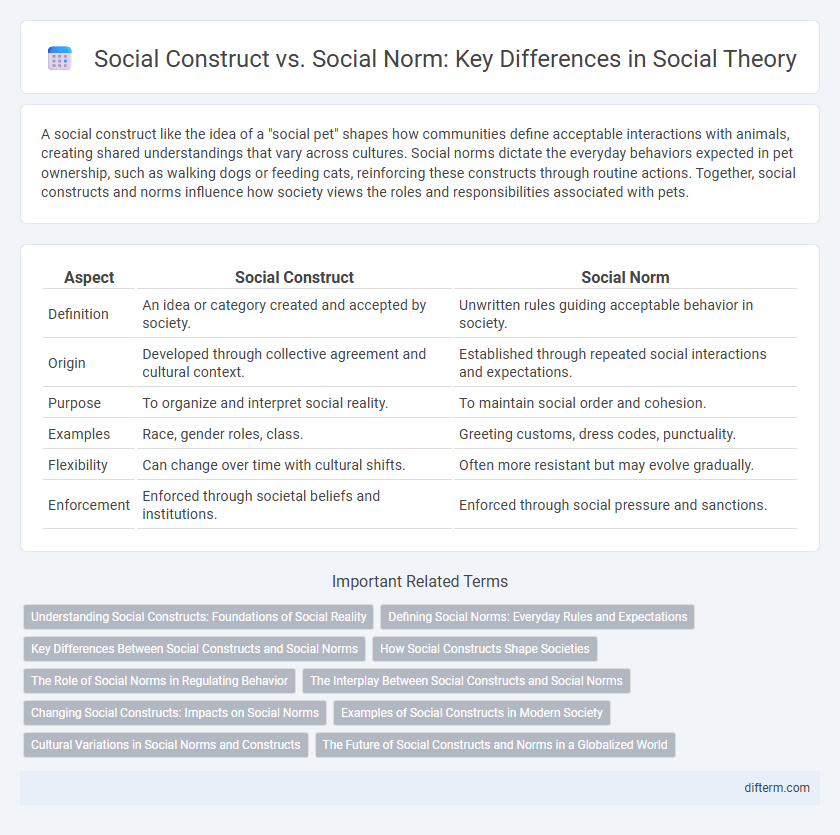A social construct like the idea of a "social pet" shapes how communities define acceptable interactions with animals, creating shared understandings that vary across cultures. Social norms dictate the everyday behaviors expected in pet ownership, such as walking dogs or feeding cats, reinforcing these constructs through routine actions. Together, social constructs and norms influence how society views the roles and responsibilities associated with pets.
Table of Comparison
| Aspect | Social Construct | Social Norm |
|---|---|---|
| Definition | An idea or category created and accepted by society. | Unwritten rules guiding acceptable behavior in society. |
| Origin | Developed through collective agreement and cultural context. | Established through repeated social interactions and expectations. |
| Purpose | To organize and interpret social reality. | To maintain social order and cohesion. |
| Examples | Race, gender roles, class. | Greeting customs, dress codes, punctuality. |
| Flexibility | Can change over time with cultural shifts. | Often more resistant but may evolve gradually. |
| Enforcement | Enforced through societal beliefs and institutions. | Enforced through social pressure and sanctions. |
Understanding Social Constructs: Foundations of Social Reality
Social constructs are collective agreements that shape societal perceptions of reality, such as race, gender, and class, forming the foundation of social identity and power dynamics. Social norms emerge from these constructs as unwritten rules guiding acceptable behavior within a group or society, reinforcing conformity and social cohesion. Understanding these constructs reveals how reality is socially fabricated and highlights the fluidity and variability of societal expectations across cultures and time.
Defining Social Norms: Everyday Rules and Expectations
Social norms are unwritten rules that govern behavior within a group, shaping everyday interactions and maintaining social order. These norms dictate expectations for conduct, such as dress codes, language use, and manners, evolving through collective agreement rather than formal legislation. Understanding social norms is essential for navigating social environments and fostering cohesion within communities.
Key Differences Between Social Constructs and Social Norms
Social constructs are shared beliefs or ideas created and maintained by society, such as race or gender, while social norms are unwritten rules that guide behavior in specific contexts, like greeting customs or dress codes. Social constructs shape broad societal perceptions and identities, whereas social norms regulate daily interactions and expectations within social groups. Understanding these distinctions clarifies how collective meanings influence social organization versus behavioral conformity.
How Social Constructs Shape Societies
Social constructs like race, gender, and class define societal organization and influence individual behavior through collective agreement rather than inherent realities. These constructs establish roles and expectations that shape social interactions, power dynamics, and cultural values across communities. The continual reinforcement of social constructs through institutions and communication solidifies social norms that govern acceptable conduct within societies.
The Role of Social Norms in Regulating Behavior
Social norms act as unwritten rules that govern behavior within communities, influencing individuals to conform for social acceptance. These norms establish expectations that regulate interactions and maintain societal order by promoting predictable and cooperative conduct. Unlike broader social constructs, social norms have immediate regulatory functions, guiding behavior through social approval or disapproval mechanisms.
The Interplay Between Social Constructs and Social Norms
Social constructs shape the framework within which social norms develop, as collective understandings of reality influence expected behaviors in society. Social norms serve as the operational guidelines, reinforcing or challenging social constructs through repeated social practices and shared values. This dynamic interplay continuously evolves cultural standards and impacts group cohesion, identity, and social order.
Changing Social Constructs: Impacts on Social Norms
Changing social constructs, such as evolving ideas about gender roles and family structures, directly reshape social norms by altering what behaviors are deemed acceptable or expected within a society. These shifts influence collective attitudes and create new frameworks for interpersonal interactions, challenging long-standing conventions and promoting inclusivity. The dynamic interplay between changing social constructs and social norms drives cultural transformation and redefines societal boundaries over time.
Examples of Social Constructs in Modern Society
Social constructs like gender roles, race, and class significantly shape individual identities and societal interactions, influencing opportunities and power dynamics worldwide. Concepts such as money and marriage are widely recognized as social constructs with standardized meanings and functions that vary across cultures and time periods. These constructs persist through collective agreement and institutional reinforcement, highlighting the fluidity and context-dependence of social reality.
Cultural Variations in Social Norms and Constructs
Social constructs and social norms vary significantly across cultures, reflecting differing historical contexts, values, and traditions that shape collective behavior and perceptions. These variations influence how societies interpret concepts like gender roles, authority, and community, demonstrating the fluidity and adaptability of social frameworks. Understanding cultural differences in social norms and constructs is essential for fostering cross-cultural communication and social cohesion.
The Future of Social Constructs and Norms in a Globalized World
Social constructs evolve as global interconnectedness challenges traditional norms, leading to more inclusive and diverse societal frameworks. Technology accelerates the diffusion of ideas, reshaping values and expectations across cultures. Understanding these shifts is essential for navigating the complexities of identity, ethics, and governance in an increasingly integrated world.
social construct vs social norm Infographic

 difterm.com
difterm.com